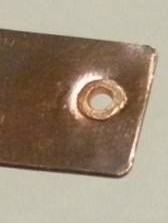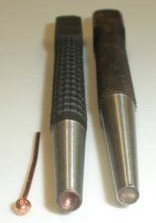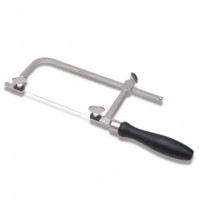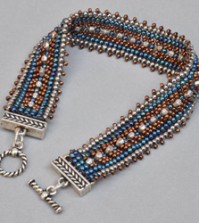- NEW DVD Series – Stone Setting with Bezels
- Tube Set Charm by Kim St. Jean
- Prong Basket Pendant by Kim St. Jean
- NEW DVD Series – Stone Setting with Cold Connections
- New DVD Series – Stone Setting with Wire
- NEW DVD Series: Introduction to Stone Setting by Kim St. Jean
- Featured Tool: Bracelet Bending Plier
- NEW Dvd by Eva Sherman
- Fun, Fast Fold Forming DVD Series
- Double Band Ear Cuff from Alex Simkin
Daily Wire Tip August 29: What are Abalone and Paua Shells?
Daily Wire Jewelry Making Tip for
August 29, 2011
Question:
Can you tell me the difference between Abalone and Paua Shell?
-Diane in Port Charlotte, Florida
Answer:


Abalone cabochon left, and paua shell cabochon, right;
the paua shell cab has been dyed
Great question, Diane! Abalone is a kind of sea snail that is not only collected for its beautiful mother-of-pearl shell, but also for its meat in some countries. Abalone can be found nearly worldwide, except the western Atlantic Sea (eastern North & South America). The name `abalone` comes from the Spanish word `abulon.` Beautiful abalone specimens can be found in New Zealand, where the Maori word for them is Paua. Some people tend to associate paua with brighter colors, such as vivid blues, pinks, and greens; paua shell cabochons are commonly dyed to enhance their color.
Abalone and paua are some of the few organic materials widely regarded as jewelry-quality, others being coral, pearl, amber, jet, and ivory. For more about abalone, there is a great deal of information in this article: Abalone
Answer contributed by Wire-Sculpture Staff

Have a Question? Click Here to Submit Your Question
Click to Receive Daily Tips by Email























Lynn Daniel
August 29, 2011 at 11:15 am
Isn’t the abalone the one on the left and the paua the one on the right?
Rose
August 29, 2011 at 11:39 am
Thanks for catching that, Lynn! I’ve updated the post.
I’ve updated the post.
Ruth Hammond
August 29, 2011 at 6:27 pm
New Zealand Paua is a shellfish belonging to the Abalone family (Haliotis Iris). It is found only in the sea around New Zealand and clings to the rocks where it feeds. Noted for the iridescent colour of its single shell’s inner surface, it could easily remain unnoticed in its natural environment due to the camouflage of its outer surface. This calcified surface is removed in the processes which prepare each shell for its use in jewellery.
Environmental Protection
New Zealand is aware of the importance of protecting its three species of Paua. Paua is considered a delicacy and strict limitations are applied to gathering it, in order to ensure its sustainability. This has increased its value, as has its reputation of being a highly desirable component in jewellery.
Colour Formation
New Zealand Paua is world famous for its colour spectrum. Each shell forms its own unique pattern. The colours can vary from greens and blues to shades of pinks and purples or even golds and crimsons, depending upon food, depth of water, temperature and location. The black patterns in the shell come from layers of protein that are formed between the layers of calcium that make up the shell. When viewed in different lights the iridescence of the shell comes into play and this effect is considered similar to that of opals.
The photo above is not indicative of usual paua shell.
Lori Crawford
August 30, 2011 at 8:52 pm
Thank you so much! Very interesting!
Jim
September 6, 2011 at 6:02 pm
I noticed in your answer to Diane about abalone shells, you didn’t mention that it should only be ground or polished with very strong ventilation, since the dust has some toxicity. Was this an oversight, or has something happened to abalone shell over the years?
Rose
September 6, 2011 at 6:08 pm
Hi Jim, thanks for bringing that up! We’d been concentrating on the finished shell cabs.
Yes, if you are interested in grinding, cutting, or polishing any kind of shell or bone, as well as stones such as azurite and malachite, a respirator is an essential tool! You can find more information here: Jewelry Safety: Soldering and Respirators. Thanks!